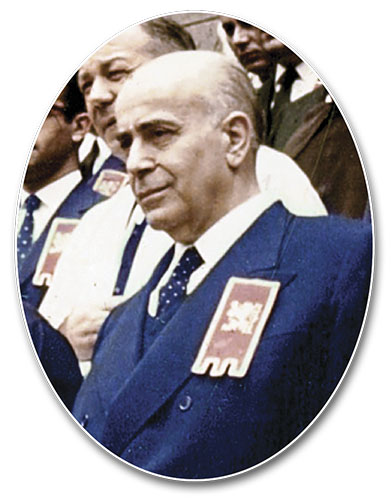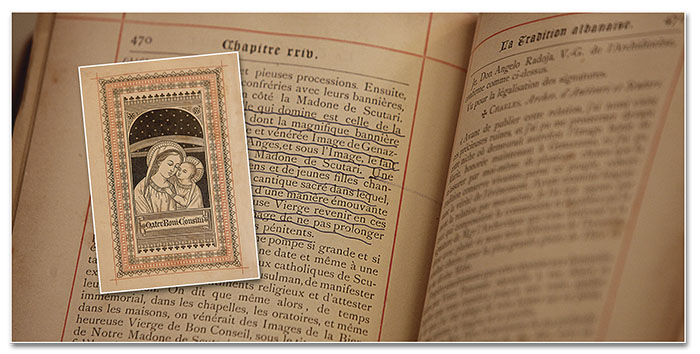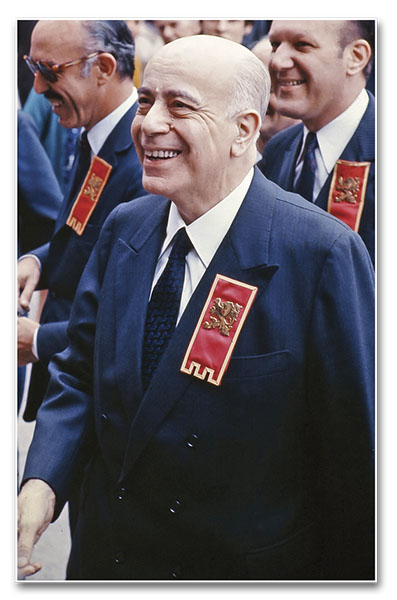On December 2 of 1967, Dr. Plinio was compelled to cancel the Saturday meeting he customary held for his disciples, leaving home only in the afternoon, to receive Communion at the Sacred Heart of Jesus Church. As he got out of the automobile, those who greeted him were shocked to see him walking with the aid of a cane and wearing a lightweight slipper on his right foot. His face showed signs of exhaustion. But, with unwavering grace, he concealed his indisposition.
On the following day, a Sunday, he could not summon the strength to leave home to fulfil his Sunday obligation, so Holy Communion was brought to him. A person who had the opportunity of spending the morning and afternoon with him said that, when greeting him, he was taken aback by the high temperature of his hand. Over the ensuing days, the fever would rise above 39 degrees Celsius. Despite this, Dr. Plinio maintained unswerving amenity, nobility and distinction of manners, as he had learned from his loving mother, Dona Lucilia.
He himself later revealed the heavy tribulation he faced on this occasion:
“When a type of abscess appeared [on the right foot], I immediately recalled the thought I had while assisting the documentary.1 It seemed to me that something absurd was happening. I was forced to spend several days at home, all the while making every effort to keep Mama from noticing anything. I got around painfully with the aid of certain props.”
As a matter of fact, very early the next day, Monday, Dr. Plinio sought medical aid. He felt as though he were entering a tunnel from which, at first glance, there was no way out. The results of the laboratory exams revealed a serious diabetic crisis. He was told to rest without exception, given a strict diet, medication and glycemic control so as to rapidly quell the physical disturbances produced by the illness. Nevertheless, a no less tragic problem remained: the development of gangrene on his right foot.
The first treatments were carried out by doctors at Dr. Plinio’s own residence. Afterwards a specialist was called in, and he concluded that urgent surgery was necessary to eradicate the serious infection.
That same night, with due care, Dr. Plinio was transferred to the Syrian-Lebanese Hospital, where he underwent surgery. There he would remain for some days of convalescence.
The greatest ordeal of his life
Nevertheless, the situation continued to be of great concern for Dr. Plinio. He was fully aware of how grave the blow to his health had been and, moreover, saw death near at hand, as he would comment shortly afterwards: “I asked myself if this was not, at last, the moment at which Our Lady, being tired of me, was going to set my soul at liberty. That was my great apprehension and my great anguish. But She would protect me even in that extremity, and I would die with my eyes fixed on her mercy.”
Indeed, on his sickbed he had trusted in that mercy and had not feared for his eternal salvation; however, what would become of the institution that he had founded, and was just now beginning to grow? He had always had the presentiment and the hope of seeing his apostolate increase to the point of victory, but now he was attacked by this piercing doubt: were the possibilities of achieving the goal of his mission to be closed off to him? And would his work be reduced to nothing after his death? This is how he expressed his perplexity at that time, when he later made a description of the events of those days: “I was certain that my death at that juncture would bring about the ruin of the efforts that were just beginning to bear fruit, and which I ardently desired to implement for the greater glory of Our Lady prior to my death.”
However, the worst of his suffering consisted in his relentless self-questioning: Could it be that he was responsible for these events, on account of some lack of correspondence to grace? With the consequence that the work would not fulfil its mission because of him? Could it be that his grave illness was a chastisement from Our Lady? And he asked himself:
“Am I not the wretch, the worst of men, on account of whose infidelity things are not going as they should? That is what torments me the most. For if I knew that my mission was to be completed, I would say to Our Lady: ‘My Mother, I deliver myself into the arms of your boundless mercy. I will expire confiding in your pardon.’ But to think that my plans would not be realized on account of my own fault! That tore at the very depths of my soul.”
A picture coming from Genazzano

Dr. Plinio in November of 1967
December 16, 1967, the first day of the novena of Christmas, was a Saturday. The heat, despite the clouds that obscured the sun, made itself felt even late in the day, making Dr. Plinio’s immobility in bed even more burdensome. He no longer had a fever, it is true, but his constitution was still greatly debilitated. His hair had turned greyer during this period, he had lost weight and his physiognomy was haggard on account of the trauma of his illness and his worries. He remained, however, always affable and paternal with everyone.
Around six o’clock he received a visit from some disciples coming from the state of Minas Gerais who were accompanied by a couple of long-standing members of his work. The Author of these lines, who held the position of expedient, was already in the room.
Dr. Plinio was very pleased to see them and, soon after the conversation began, one of them explained that he had taken advantage of a friend’s journey to Rome to ask him for the favour of purchasing a certain picture, in order to give it to Dr. Plinio as a present.
It was a framed print of Our Lady of Good Counsel of Genazzano, Mater Boni Consilii, a copy of the miraculous fresco found there since the fifteenth century. While they unwrapped the packaging, Dr. Plinio remarked:
“I have just finished reading a book about the image of Genazzano.”
Providential reading, a source of consolation
In fact, eight months previously he had read a work in French concerning the history of Our Lady of Good Counsel written by an Australian missionary priest, Msgr. Dillon,2 who had spent a long stay in Genazzano, being witness to one of the miracles that had taken place there. This priest described, in particular, the supernatural phenomenon of the changing of the colours and of the expressions in the fresco, and mentioned the abundance of interior inspirations received by people who had visited it, in conformity with the external changes in its physiognomy. And such changes were also conveyed by means of reproductions of the image of Genazzano.
Despite the ordeals through which he had passed, Dr. Plinio experienced great spiritual joy from reading this work on many evenings prior to going to bed.
Progressing in his reading, he understood the degree to which devotion to Mater Boni Consilii was suitable for instilling the virtue of confidence, of which he had such need at that time. And, after having underlined various parts of the book, he dedicated a talk to the history of Our Lady of Good Counsel of Genazzano. He also made numerous comments about it on the occasion of the symposium attended by members of the group from Minas Gerais, and it was these references that inspired some of them to order a reproduction of the fresco.
The grace of Genazzano: a smile and a promise
Dr. Plinio was almost sitting up in bed, reclining on several pillows, when the portrait of Mater Boni Consilii was presented to him. It rested on his legs as he took it into his hands.
Absorbed, enchanted and genuinely emotional, for twenty minutes Dr. Plinio gazed at the picture, without averting his eyes and maintaining a silence that was only interrupted by exclamations:
“What a magnificent image! So striking, so extraordinary! But what a wonder! How expressive She is! Look, it seems as if She is speaking. She is changing colour. Now She has another expression! How generous and maternal She is! She smiles, always ready to help! There are no words; one does not know what to say!”
Indeed, although he had not described everything he saw in the image, all who were present agreed in affirming that the picture of the Most Holy Virgin had had an intense manifestation in his presence, changing its expression and its colours, as if it were in fact smiling. So, without the least doubt, the interior experience that Dr. Plinio was to call the grace of Genazzano from that time forward was an authentic and profound mystical grace whose meaning was evident. And one could see his own physiognomy transformed, reflecting an extraordinary consolation, almost an ecstasy!

Later, when the Author had the opportunity to question him about this, he revealed what had transpired at that time. And he was subsequently to make countless references to this event in conversation as well as in public meetings. “At the moment when I looked at the picture, I had the distinct impression that the image came to life, smiled and made me understand, by the facial expressions, that I should have complete confidence,” he related twenty years later.
“I am certain that it was a grace, a promise,” he would always affirm without doubt, and on other occasions he would refer to the “smile-promise of Our Lady.” But what was the promise She transmitted to him?
Without exactly having heard a voice, Dr. Plinio felt in the depth of his soul Mary Most Holy’s caress, whose significance was crystal clear: “My son, do not be disturbed. Confide, because your work will be completed and you will fulfil your mission entirely.” That guarantee was what he had most desired, for it resolved the terrible question that had been afflicting him.
Furthermore, that interior consolation also brought a special note of encouragement and incentive to his struggle, as he would describe on another occasion: “What was the grace of Genazzano? A specific display of affection, but with the attitude of a Queen who says to her soldier: ‘Do not panic or retreat, because I take all the responsibility.’ She was entirely and discreetly majestic, grave and maternal, as if to say: ‘You will pass through trials that are going to horrify and terrify you, but remember what I am saying now: I will overcome everything!’” And the message was so clear and well-defined that it left no room for the slightest doubt, something which is characteristic of prophetic communication. “I had the certainty of having clearly heard the words spoken,” he would acknowledge in all simplicity. That grace of certainty acted in his soul in such a way as to give him the ability to carry the burden of his trials with ease, and he told the Author that he sometimes asked himself: being assisted by such certainty, would there be any merit for him in believing that which had been promised to him?
In short, the grace of December 16, 1967 consisted in exactly that confirmation and in the certainty of the total fulfilment of Dr. Plinio’s mission and the continuation of his work, that is, the defeat of the Revolution and the establishment of the Reign of Mary.
Whoever saw him then would have had the impression of looking upon a crusader who, after having walked hundreds of miles and fought countless battles, had finally succeeded in entering Jerusalem and reaching the Holy Sepulchre where Our Lord Jesus Christ had been entombed. He would have shown every sign of fatigue and of struggle, but he would have felt a tremendous sense of consolation. That is how it was with Dr. Plinio: all of his suffering seemed to have been compensated by the grace he had received, and he was entering into a new phase of his spiritual life.
On the following day, December 17, the surgeon decided that Dr. Plinio’s state was sufficiently improved that, contrary to all expectation, he was able to discharge him.
The virtue of confidence throughout his whole life

Dr. Plinio in 1969
When conversing with the Author during those days, Dr. Plinio commented that he had studied the physiognomies of the doctors in order to understand his own illness, and that he had perceived that the data obtained by means of his observations did not harmonize with the information they had provided. In other words, he had drawn his own conclusions, and well understood that his recovery was owed much more to the intervention of Our Lady than to their care.
Indeed, the grace of Genazzano had been of fundamental importance to his recuperation. And, from 1967 onward, he was to say many times that without supernatural help he would have died.
“I would not have survived without the grace of Genazzano,” he would affirm more than fifteen years after the event, subsequently adding: “Without the grace of Genazzano, my heart would have stopped beating a long time ago and I would be dead.” And again: “With so many concerns, if it had not been for the promise of Genazzano I would have died, because I could not have endured the uncertainties and doubts. But, with that promise, I had a guarantee. I was to continue in peace, seeking to prolong my life, not because my eyes had seen my Saviour, but because the ears of my soul had understood the promise of His Mother. Therefore, I had to forge ahead! And so it was possible to preserve my tranquillity and stability in confidence.”
“When I had fallen ill, even before receiving the grace of Genazzano I perceived that my sole duty was to have a confidence so placid and complete that I never inquired much into my illness. I kept myself informed, but absolutely never agonized over it. And the grace of Genazzano confirmed that demeanour: after I learned of the nature of my infirmity I understood that, if I had been shipwrecked in the maelstrom of despair, the progress of the malady would have been unstoppable.”
And so his life was entirely characterized by hope from beginning to end. And, as ever in defiance of appearances to the contrary, he believed in the interior message given by Our Lady and waited for the fulfilment of her promise. That virtue, infused in his soul at the moment of Baptism, accompanied him in a special way throughout the length of his illness in 1967 and never left him even at the hour of his death.3 ◊
Notes
1 On November 5, 1967, Dr. Plinio attended, in a very prominent place, a solemn Mass celebrated in the Cathedral of São Paulo. Various aspects of the ceremony and of the participants were filmed inside the church and on its steps. A few days later, Dr. Plinio was invited to watch the documentary. When he saw himself on the screen, he was astonished to see how much his physical vigour had been undermined, probably due to some serious illness.
2 This book was La Vierge Mère du Bon Conseil, by Msgr. Georges F. Dillon, published by Desclée de Brouwer in 1885.
3 Text taken, with adaptations, from: Dona Lucilia. Città del Vaticano-Nobleton: LEV; Heralds of the Gospel, 2013, p.618-619; O dom de sabedoria na mente, vida e obra de Plinio Corrêa de Oliveira. Città del Vaticano-São Paulo: LEV; Lumen Sapientiæ, 2008, v.IV, p.281-295.


